Leavened bread

This recipe is designed for baking bread in a wood-fired oven but, of course, you can use the conventional oven in your kitchen.
- 1
 150 g leaven
150 g leaven - 2
 500 g plain white flour (French Type 65)
500 g plain white flour (French Type 65) - 3
 9 g salt
9 g salt - 4
 220 ml water
220 ml water - 5
 0.5 g yeast (optional)
0.5 g yeast (optional) - Total weight: 880 grams
Step by step recipe
Stage 1 - 5 min.

You can calculate the temperature of the water for this recipe in one click, using this small calculator.
Stage 2 - 10 min.

Then knead on minimum speed for 3 minutes, and 3 further minutes a little faster (speed "1").
Note: For the best way to knead, see: A few tips for effective kneading at home.
Stage 3 - 10 min.
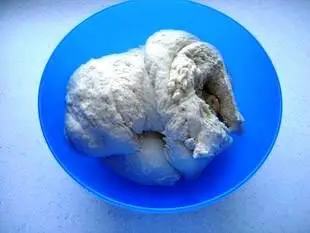
It needs to rest for approximately 10 minutes.
Stage 4 - 3 min.

You now need to "structure" or work the dough to obtain a beautiful even ball from this heap of dough. The ball should have a well rounded top and a base which is called the seam, where the folds join.
To achieve this, fold the sides of the dough into the centre, using the heel of your hand. This first stage kneading (a lighter touch than for hard-wheat dough) French bakers call "frasage".
Stage 5

Stage 6 - 3 hours

Leave to rise in a warm draught-free place, for approximately 3 hours, this first rising is the "pointage" (starting) in French.
Stage 7 - 5 min.

The best way to do this is to press gently on the dough with your hands to crush out the gas bubbles (you may well hear "pschhh" as the gas escapes).
Stage 8 - 5 min.
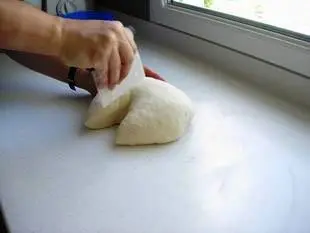
The photo shows 2 loaves of approximately 800 g, but with this amount of dough you could make one large round loaf.
Stage 9 - 5 min.
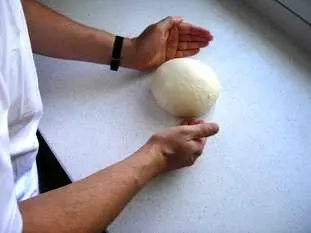
Eventually you should get beautiful round shapes again.
For round loaves the shaping is now complete.
Stage 10 - 3 min.
For this, turn the ball over and roll it up on itself while at the same time rolling it on the work surface.
Foot-note: It's a difficult action to describe, so you can watch it in the short video on the right.
Stage 11

Note: the smooth face which will be the top of the bread should be placed downwards, and the seam on top, because the loaves will be turned over before putting in the oven.
Stage 12 - 2 hours

Stage 13

When the dough is ready (well risen), it's time to bake.
Flour the peel (bread oven "shovel") and the surface of the loaf, then turn it out onto the peel.
You can also put the peel on top of the bread, and turn the whole lot over in a smart but smooth action. Then remove the basket.
If you are baking in your kitchen oven, put the loaf on a baking sheet.
Stage 14

Stage 15 - 40 min.
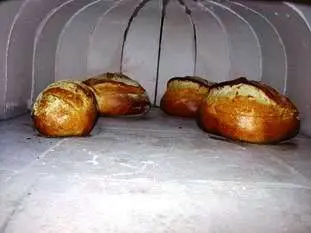
Note: As when baking any bread, you should ensure that the oven is filled with steam for the first 15 minutes of baking. This page shows you how; it really is the secret of golden-brown, crusty loaves.
Stage 16

The golden loaves crackle delightfully while cooling ...
Stage 17

Stage 18

Stage 19
Note: it's a non-audio film, except for strategic moments.
If you wish to increase or decrease the amount of dough, you can use this small converter, just enter the quantity of flour, or water or leaven, and it will calculate automatically the weight of the other ingredients necessary. It's also possible that according to the quality of your flour, your dough will be too soft, not firm enough, in this case reduce the water volume.
The very small quantity of yeast (0.25%) is important for the rising of the bread. Note that the French legislation authorises bakers to add up to 2g yeast per kilo of dough in their "leavened bread", and this they do, even the most renowned...
You will find it's easier to succeed if you make large round loaves.
When familiar with this recipe, try the special breads or the new leavened bread (a bit more sophisticated).
Yeast in leaven-raised bread?
Many of you are puzzled by the presence of yeast in a leaven-raised bread. Here is a little clarification of the matter:The yeast is there to make things easier; for a beginner leaven-raised bread is not easy to get right, especially first time. This is why these few added grams of yeast help. The dough rises more easily, even if your leaven is not at its best, and it makes a lighter crust.
There's nothing shocking in this. You should be aware that even some commercially produced breads advertised as "leavened", also contain a little (more) yeast, for similar reasons, and it's perfectly legal.
In any case, there's no reason to be worried about yeast; it's not a chemical product. It too is a living organism, and it's not added to work against the leaven, rather something you can use alongside if you wish. Being able to proclaim proudly, "I don't use any yeast!" is, in my humble opinion, rather overrated.
That said, adding a little yeast does have one slight drawback, in that it dulls the flavour of the bread somewhat. If you want to make leavened bread for its characteristic flavour, you'll lose a little, even with a small quantity of yeast.
In conclusion, I advise the following approach: if you are just starting out, add a little yeast. Then, once you have mastered the basics and can produce good bread, leave it out. You can then compare both methods and choose.
I'll finish with a short quotation: "I will make you a bread so good that that will not be an accompaniment anything else, but a food for gourmets" (Actor Raimu for Author/Director Marcel Pagnol in the movie "The Baker's Wife").
| Proteins (gr) | Carbohydrates (gr) | Fats (gr) | Energy value (in k-calories) | Energy value (in k-joules) | |
|---|---|---|---|---|---|
| Whole recipe | 70 RDI=30 % | 570 RDI=50 % | 10 RDI=2 % | 2,030 RDI=100 % | 8,480 RDI: 100 % |
| Per 100 g | 8 RDI=3 % | 70 RDI=6 % | 1 RDI=0 % | 230 RDI=10 % | 970 RDI: 10 % |
- For 1 loaves : 1.00 €
White asparagus salad
This spring salad combines warm white asparagus, hard-boiled eggs and small croutons, dressed with a tasty herb vinaigrette.
129 K4.3 50 min.
Smoked eggs
This sophisticated, smoky flavoured starter consists of an egg yolk, heated in a bain-marie and a smoked cream mousse with a scattering of chives, served with a buttered-toast "soldier".
74 K4.9 12 hours 30 min.
Salad lyonnaise
Salad lyonnaise conjures up the cuisine of the French city of Lyon and the region around: traditionally a salad of dandelion leaves with croutons, lardons and poached eggs. Here is a slightly simpler version with shredded lettuce instead of dandelions.
33 K 45 min.
Home-made breadcrumb coating
The crispy crust on many fried (or baked) foods comes from a breadcrumb coating. You can buy this, of course, but it's easy and much better to make your own at home. For one thing, you will know excatly what's in it – just bread – which is not the case for the commercial product. This is also a...
125 K1 1 hour 7 min.
Tender roasted carrots with avocado mayonnaise
Roasted new carrots with Provencal flavors, served with toasted bread and a delicious avocado mayonnaise.
15 K 50 min.

Plain white flour (French Type 65)
Like these other recipes: Mustard baps, Hamburger buns, Roscoff loaf, Bacon rolls, Seeded loaf, ... See them all 19

Water
Like these other recipes: Caramel semolina pudding with raisins, Shortbread tart with sweet apricots and rosemary, Toffee apple upside-down cake, Bacon rolls, Ali Baba bread, ... See them all 136

Leaven
You can get more informations, or check-out other recipes which use it, for example: Old style brioche, Yeast-based flaky dough (for croissants), Seeded loaf, Peanut rolls, Special small breads, ... See them all 21

Salt
Like these other recipes: Turban of sole with langoustines, Roasted cauliflower, Crunchy little pieces of fish, Buckwheat pancakes, Whiting fillet with mustard carrots, ... See them all 657
Brioche dough
It's a soft and rich dough, with butter and eggs which give a smooth and incredibly tasty brioche. This is the basic recipe for brioche dough, used for all other brioche-based recipes on the site.September 16th 2020536 K 44.2 14 hours 30 min.
Confectioner's custard (Crème pâtissière, or French pastry cream)
Quite similar to crème anglaise but much thicker. It is used in many pastries like choux pastry (pâte à choux) or millefeuille.January 27th 2017767 K 313.7 40 min.
Couscous
In couscous, the meat and vegetable mixture is rather long to cook, but not difficult. And the couscous itself (a kind of coarse semolina) is simple and quick to prepare.November 16th 2017526 K4.3 2 hours 40 min.
Green parsley sauce
This sauce, with a great parsley taste, is perfect with steamed vegetables or fish. At the bottom you will find the coulis version of this recipe.February 21th 2011535 K 44.3 25 min.
Morteau sausage
In this recipe, Morteau sausages are cooked on a bed of chopped potatoes. The trick is to cook the Morteau sausage slowly, so that its delicious, smoky flavor descends on the potatoes, which are crispy on the outside and melt-in-the-mouth on the inside, a pure delight.September 29th 20241.24 M 34.1 1 hour 35 min.
Sign up to receive the latest recipes (next batch due to be sent on 2025-08-31)



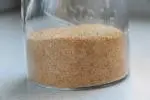






The 2 comments already posted on this recipe